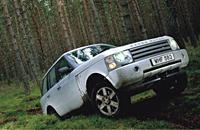THE EVOLUTION OF A CLASSIC BRITISH DESIGN - THE NEW RANGE ROVER
 |
London, November, 2001 – Imposing, avant-garde, distinguished by striking features, yet still clearly a Range Rover – these are the ingredients that best describe the latest interpretation of the world’s pre-eminent luxury off-road 4x4.
Led by Land Rover design director Geoff Upex, the design team behind the third generation Range Rover has created a vehicle that blends key styling cues with eye-catching modern ‘jewellery’.
Many of the traditional Range Rover elements have remained with the vehicle since the original was launched more than 30 years ago and today form an integral part of the Range Rover’s design DNA. In essence, a Range Rover would not be a Range Rover if it did not have the practical horizontally split tailgate, the bold upright front with its simple grille, the command driving position, the ‘floating’ roof, the clamshell bonnet with its castellations and the almost rectangular interplay between the horizontal and vertical body lines.
The new Range Rover embodies all those iconic features, yet moves the design firmly into the 21st Century with uniquely styled head and tail lamps and distinctive – and functional – power vents. These metal-look vents on the trailing edges of both front wings help increase the amount of air fed to the engine, while the eye-catching headlamps are both stylish and efficient.
In order to make the new Range Rover more spacious inside, the new vehicle is bigger externally than its predecessor – it has grown longer and taller and has greater ground clearance than before. The imposing new Range Rover is some 4950 mm (195 in) from bumper to bumper and sits on a wheelbase of 2880 mm (113.4 in), increases of 237 mm (9.3 in) and 135 mm (5.3 in) respectively. At 1863 mm (73.3 in) tall, it has grown 45 mm (1.8 in) over the previous car.
Ground clearance, one of the most significant dimensions for an off-road vehicle, has risen by 67 mm (2.6 in) to 281 mm (11.1 in) when the Range Rover is on its highest suspension setting.
The efficient packaging of the new Range Rover provides greater interior space even though its overall dimensions are narrower. The body itself is 67 mm (2.6 in) wider at 1956 mm (77.0 in) but the overall width – including the door mirrors – is slightly reduced by 37 mm (1.5 in) to 2191 mm (86.3 in). This eases its ability to thread through gaps both in traffic and off the beaten track without compromising passenger comfort.
Larger external dimensions translate directly into more interior space. There is more head, leg and shoulder room for those in the front and an improvement in knee room for those in the rear. In addition, the luggage area is longer and taller than before, with the overall volume rising from 513 litres to 535 litres.
Interior
If the exterior of the new Range Rover can be seen as an evolution of the traditional shape, the sumptuous interior represents a real revolution.
Typical Range Rover customers know and understand luxury and the interior of the new vehicle reflects the understated quality they expect. While developing the interior of the car, the design team took styling and texture cues from products as diverse as audio equipment, ocean-going yachts, first-class airline seating, fine furniture and jewellery, combining these concepts with the classic ‘wood and leather’ experience expected from a Range Rover.
At the same time, the need for a simple cockpit layout was not forgotten. A minimalist approach to the controls is vital in an off-road vehicle where safety could be compromised if the wrong control was to be used inadvertently at a crucial point.
The result is an interior that brings new levels of luxury to the Range Rover yet remains classically elegant and supremely functional.
Another theme central to the new Range Rover is one of choice. Although there is only one body style and an option between just two engines (3.0-litre six-cylinder turbodiesel and 4.4-litre petrol V8), a huge choice of interior styles and shades and exterior colours make it possible for customers to specify a bespoke Range Rover.
To complement the 12 exterior colours, there are three interior trim finishes, featuring cherry wood, burr walnut and a more sporting alloy metal look called foundry. There are also three seat fabrics – cloth, traditional Blenheim leather or Oxford leather.
A discreet metal finish is used for the detailing around the instruments and controls.
A special emphasis on comfort provides the new Range Rover with the most luxurious seating yet. As well as foldable armrests front and rear, optionally available ‘Contour’ front seats have an electrically adjustable split backrest to allow the occupants to achieve the perfect seating position. Electric control extends to the head rests and there is also a memory facility.
Split rear seats fold on a 60/40 basis and ‘jack-knife’ forward to increase luggage space. The cargo area has luggage loops to allow loads to be securely fastened and there is a ski hatch and bag in the middle of the rear seats.
Heating elements can be specified for all the seats as well as the steering wheel, the warmed leather rim being especially welcome in winter.


